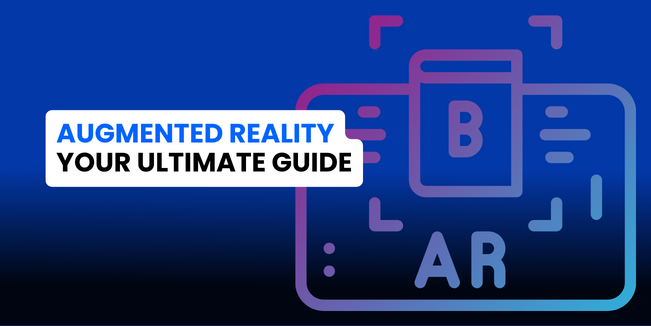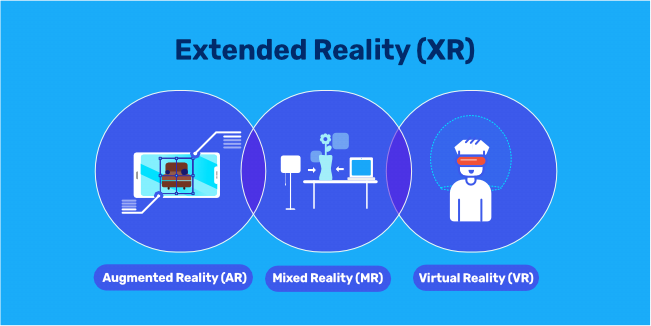Augmented Reality - everything you need to know

Augmented Reality is the future technology that will revolutionize the world and allow companies to gain a market advantage. In today's crowded market, it is impossible to imagine mobile app development that will not align with the latest trends and user expectations. In addition, AR has a number of business applications that improve productivity, facilitate employee training and streamline all processes. Whether your company produces furniture, provides services, or operates in the entertainment industry, modern technologies such as augmented reality, artificial intelligence, or machine learning will help you succeed. In addition, AR is available to almost every user, which makes its potential even greater.
What is Augmented Reality (AR)?
The term "augmented reality" has been around since 1990. Through holographic technology, augmented reality is an interactive version of the real environment obtained through digital visuals, sounds, and other sensory stimuli. AR combines three features: the combination of the digital and physical worlds, real-time interactions, and accurate three-dimensional identification of virtual and real objects.
Augmented reality is used to visually change the natural environment or provide users with additional information. The main advantage of the AR system is that it manages to combine digital and three-dimensional components with individual perceptions of the real world. AR has a vast potential that is used in many industries. Technology development has meant that almost everyone can access augmented reality applications, provided they have at least a smartphone.
How Augmented Reality works?
Augmented reality is available in several convenient forms, such as smartphones, tablets, and glasses. And soon enough, it'll be accessible even through contact lenses! For AR to function correctly, specific hardware components must exist within the device; most mobile devices have these, which makes augmented reality easier for a non-professional user to access.
Some AR software (e.g., used by the military to train soldiers) may also include machine vision, object recognition, and gesture recognition. If an AR device is not equipped with the necessary computational power, AR processing can be shifted to another machine, which helps ease its intensive demands.
AR apps are designed to bring digital information and animation into the world around us. It is achieved by writing programs in 3D, which allow developers to attach contextual data or visuals onto real-world markers. When an AR application or browser plug-in receives a signal from one of these tags, it starts executing its code and displaying the correct image(s). By utilizing augmented reality technology, users can, e.g., experience rich multimedia content wherever they go.
Types of Augmented Reality

When deciding what kind of AR technology you will need for your business, you must first determine what kind of AR to use. There are four types of augmented reality. Choosing one of these types will determine how you can display your images and information.
This type of AR relies on the identification of user-defined markers/images. Markers are distinct patterns that cameras can easily recognize and process and are visually independent of their surrounding environment; these can be paper objects or physical objects that exist in the real world. Marker-based AR requires a marker to activate the upgrade.
Marker-based AR scans a marker that triggers an enhanced experience (object, text, video, or animation) that appears on the device. It usually requires software in the form of an application that allows users to scan markers from their device using the image from the camera.
Marker-less AR gives the user the most control, allowing them to choose where to place the content. It also allows you to place virtual, augmented objects on a real scale. These AR experiences rely heavily on smartphone features such as sensors, cameras, and processors.
This type of AR involves rendering virtual objects in or on the user's physical space. It is one of the simplest forms of AR, where light is projected onto a surface. Interaction takes place by physically touching the displayed surface.
In Project-based AR, the user is not limited to any device because virtual objects are integrated directly into the environment; users and targets can also navigate the environment within a defined zone that houses a fixed projector and a tracking camera to support it. Project-based AR methods can create illusions about an object's depth, location, and orientation.
Superimposition-based AR consists in wholly or partially replacing the original view of an object with an enlarged view of the same object. In this type of AR, object recognition plays a vital role because the application cannot replace the original object with the extended one if it cannot identify the original object. Superimposition-based AR has been popularized by social media platforms such as Instagram and Facebook.
AR vs. VR vs. MR vs. ER
Augmented reality is developing extremely dynamically, leading to the development of various digital realities. Their differences are subtle, but it is worth knowing them to choose the best variant for your project consciously.
Augmented Reality offers an unforgettable experience by adding visual, auditory, and tangible components to real-world objects. Unlike virtual reality, which creates an entirely different simulated environment, (AR) Augmented Reality brings life to your current surroundings - seamlessly blending what's virtual with reality itself. Moreover, AR devices are far more flexible than other technology.
Companies are capitalizing on this innovative technology in various ways, such as launching revolutionary marketing campaigns, promoting products or services, and capturing unique user data – all with minimal effort!
It is a three-dimensional image created using information technology, which imitates the existing real-world environment or is a vision of a fictional world. Simply put, it is a computer-generated environment in which we can completely immerse ourselves. To do this, the user needs special VR goggles that display the image in 3D and 360 degrees; after putting them on, we do not see any real-world elements. In addition, the sets are equipped with headphones - their task is to emit sounds from the application, thanks to which we surrender to the impression of being in a new reality even more. The sensations are intensified by controllers that transfer the performed movements to the computer world.
Mixed reality combines virtual and real objects, so it is a combination of Virtual Reality (VR) and Augmented Reality (AR). MR means environments where real and virtual entities and objects can interact with each other in real-time and where the user can interact with real and virtual elements.
Extended reality (XR) means a set of technologies that combine the digital environment with the real one and enable human-machine interaction in this virtual environment. It includes all kinds of technologies that enhance our senses, including the three types mentioned earlier.

Where can AR be used?
It is commonly believed that augmented reality is used mainly in games or as pleasant entertainment. Meanwhile, AR has found applications in many business industries. Considering that it is developing dynamically, the list below is not final. Currently, AR systems are used in the following industries:
It is impossible to list all the applications of AR in education because it can be used to learn everything: from foreign languages, through drawing, to advanced mathematical, physical, and chemical models. It is worth noting that the AR system can be used in applications for users of all ages, from children, teenagers, and students, to adults.
AR is an invaluable support when performing medical activities. It is known to use AR to display the subject's anatomy based on a previously served tomography examination. AR allows you to conduct operations in a computer-generated world without the slightest risk in the event of failure.
AR is a powerful tool that can be used in marketing and advertising campaigns. The most famous example of using AR in an advertising campaign was the "Unbelievable" campaign created by Pepsi Max. It was an event that the media all over the world wrote about. And all thanks to a unique screen located at one of the stops in London. People waiting at the bus stop suddenly saw unusual effects from computer games. And since they were not informed that it was AR, their reactions were highly spontaneous.
AR can improve the customer experience by presenting them with 3D models of products and helping them make better choices. Customers can apply 3D elements to their spaces, for example, when buying furniture, to choose the pieces that best suit their space – in terms of size, shape, color, and type. For this reason, applications used to furnish flats and houses are very popular.
AR Technology helps improve productivity by overlaying relevant information in the worker's field of view while performing tasks. Advanced AR systems can not only understand the context of a given situation but also help identify components and workflows.
Augmented Reality is starting to play an increasingly important role in the military. Among other things, AR helps advance navigation or mark objects in real-time. It also allows for the practical training of soldiers.
Augmented Reality can be used for navigation and to provide interactive information about destinations, suggest exciting places to visit, or even plan sightseeing according to the user's individual preferences.

AR can help architects visualize their construction projects. Advanced AR systems can also draw attention to elements that can cause malfunctions or even disasters in the real world.
Augmented Reality revolutionizes archaeological research by enabling archaeologists to reconstruct sites virtually. Not only does this assist researchers in their work, but it also provides an immersive experience for museum visitors and future archaeologists.
AR is used in games, but that's not all. Increasingly, AR technology is appearing in applications that aim to entertain users by creating increasingly compelling AR experiences that blur the line between reality and virtuality.
Conclusion
AR can help your company gain a market advantage and delight users and customers. By embracing augmented reality, you can bridge the physical and digital domains to manage your personnel better, tackle challenges more quickly, maximize efficiency, amplify output levels, and foster collaboration between team members.
If you want to find out how we, as the best product development company, use AR in our projects, make an appointment for a free consultation with our specialists. AR is the future of technology, so follow the trends and create innovative products with us that will conquer the world.